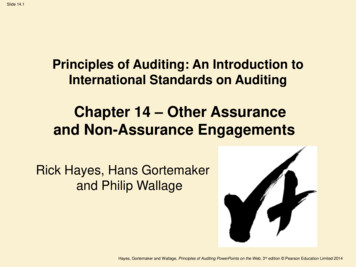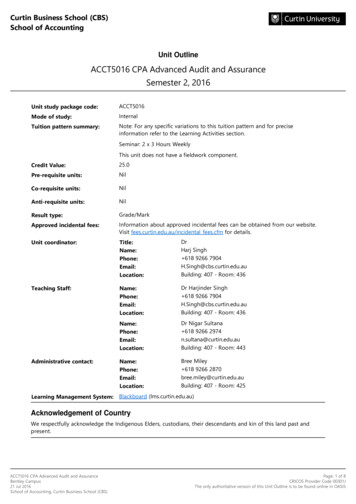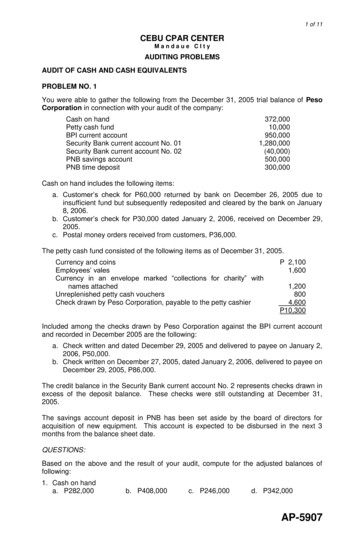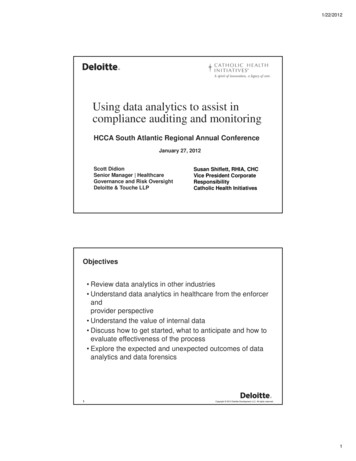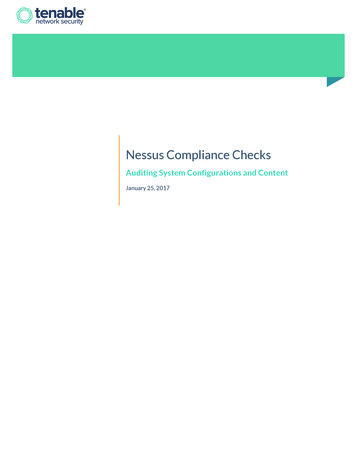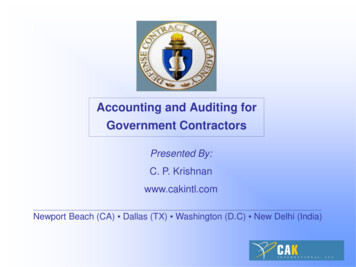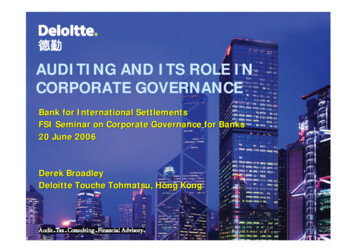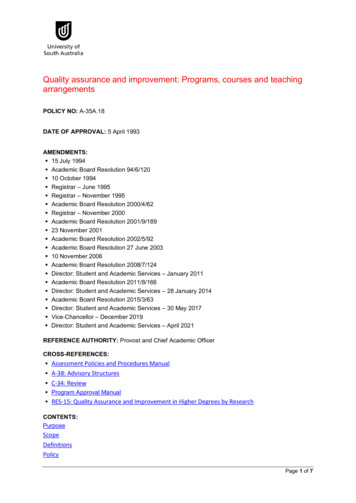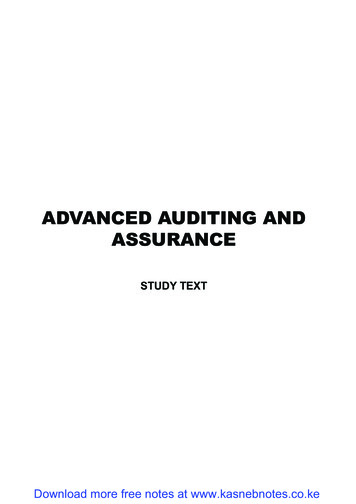
Transcription
ADVANCED AUDITING ANDASSURANCESTUDY TEXTDownload more free notes at www.kasnebnotes.co.ke
iiA D VA N C E D A U D I T I N G A N D A S S U R A N C ECopy r i ghtALL RIGHTS RESERVED.No part of this publication may be reproduced, stored in a retrieval system or transmitted in any form or by anymeans, electronic, mechanical, photocopying, recording or otherwise without the prior written permission ofthe copyright owner. This publication may not be lent, resold, hired or otherwise disposed of in anyway of tradeS T U D YT E X Twithout the prior written consent of the copyright owner.ISBN NO: 9966-760-26-1 2009 STRATHMORE UNIVERSITY PRESSFirst Published 2009STRATHMORE UNIVERSITY PRESSP.O. Box 59857, 00200,Nairobi, Kenya.Tel: 254 (0) 20 606155Fax: 254 (0) 20 607498Design Concept & Layout - Simplicity Ltd - P.O Box 22586-00400 Nairobi. Email: info@simplicityltd.comDownload more free notes at www.kasnebnotes.co.ke
ACKNOWLEDGMENTiiiS T U D YWe gratefully acknowledge permission to quote from past examination papers of KenyaAccounts and Secretaries National Examination Board (KASNEB).T E X TAcknowledgmentDownload more free notes at www.kasnebnotes.co.ke
A D VA N C E D A U D I T I N G A N D A S S U R A N C ES T U D YT E X TivDownload more free notes at www.kasnebnotes.co.ke
vTABLE OF CONTENTSACKNOWLEDGMENT . . iiiTABLE OF CONTENTS. vCHAPTER ONE. 3INTRODUCTION TO AUDITING . . 5CHAPTER TWO . . 47ACCOUNTING AND INTERNAL CONTROL SYSTEMS: THEORY AND PRACTICE. 49CHAPTER THREE .119THE AUDIT PROCESS: PLANNING AND QUALITY CONTROL . . 121CHAPTER FOUR. 147THE AUDIT PROCESS: VERIFICATION OF ASSETS AND LIABILITIES . 195CHAPTER SIX . 263THE AUDIT PROCESS: FINAL REVIEW OF AUDIT OF FINANCIAL STATEMENTS . . 265CHAPTER SEVEN . 279SPECIALIZED AUDIT SITUATIONS . 281CHAPTER EIGHT . 305EXTERNAL AUDITORS REPORTS AND OTHER REPORTS . 307CHAPTER NINE . 359AUDIT INVESTIGATIONS, RECEIVERSHIPS, LIQUIDATIONS AND CURRENT ISSUESIN AUDITING . . 361CHAPTER TEN . 425ANSWERS TO THE EXAM QUESTIONS . 427REFERENCES . 483GLOSSARY . 487INDEX . 493Download more free notes at www.kasnebnotes.co.keS T U D YCHAPTER FIVE . 193T E X TAUDIT EVIDENCE AND DOCUMENTATION. 149
A D VA N C E D A U D I T I N G A N D A S S U R A N C ES T U D YT E X TviDownload more free notes at www.kasnebnotes.co.ke
1STS TT SUU TDDUYYD YT EE TXX ETTX TCHAPTER ONEINTRODUCTION TO AUDITINGDownload more free notes at www.kasnebnotes.co.ke
A D VA N C E D A U D I T I N G A N D A S S U R A N C ES T U D YT E X T2Download more free notes at www.kasnebnotes.co.ke
3CHAPTER ONEINTRODUCTION TO AUDITINGOBJECTIVESWhen you have studied this chapter you should be able to: Explain and discuss the nature of auditingDescribe and discuss the regulatory framework for auditing and related servicesinternationally and in KenyaDescribe the provisions of the Accountants Act, Cap 531 in relation to professionalmisconduct.DEFINITION OF KEY TERMS1.2.Auditing the independent examination of and expression of opinion on, the financialstatements of an enterprise by an appointed auditor in pursuance of that appointmentand in compliance with any relevant statutory obligation:An engagement letter defines clearly the extent of the auditor’s responsibilities and sominimise the possibility of any misunderstanding between the client and the auditor.Non-statutory audits performed by independent auditors because the owners,proprietors, members, trustees, professional and governing bodies or other interestedparties desire them, not because the law requires them.EXAM CONTEXTA complete understanding of the introduction to audit and assurance is essential as it helps theexaminee tackle technical terms and have a deeper understanding of the questions. Nearly allquestions will have something on the introduction to auditing and assuranceINDUSTRIAL CONTEXTAuditing as a profession plays an important role in ensuring that companies present a true andfair view of the financial statements to the different shareholders. Public Companies are requiredto publish audited financial statements at the end of the financial year.Download more free notes at www.kasnebnotes.co.keS T U D YThe chapter covers the basic concepts and regulation that affects the auditing profession. Auditingis a key part of good corporate governance but the directors are responsible for maintaining asystem of control that will safeguard the companies assert thus it gives guidelines of the factsthat auditors must be aware of as part of their planning for carrying out a true and fair reportT E X TINTRODUCTION
4A D VA N C E D A U D I T I N G A N D A S S U R A N C E1.0DEFINITION OF AUDITINGAccording to the International Standard on Auditing (ISA) No. 200 Objective and General PrinciplesGoverning an Audit of Financial Statements, the objective of an audit of financial statements isto enable the auditor to express an opinion whether the financial statements are prepared, in allmaterial respects, in accordance with an identified financial reporting framework.The phrases used to express the auditor’s opinion are “give a true and fair view” or “present fairly,in all material respects,” which are equivalent terms. A similar objective applies to the audit offinancial or other information prepared in accordance with appropriate criteria.S T U D YT E X TThe Institute of Certified Public Accountants of Kenya (ICPAK) defines auditing as the independentexamination of and expression of opinion on, the financial statements of an enterpriseby an appointed auditor in pursuance of that appointment and in compliance with anyrelevant statutory obligation:1.1 RELATED SERVICESIn addition to audit services, auditors provide other services. These can be classified as:Assurance engagements AuditsReviewsNon-assurance Engagements (related services) Agreed upon ProceduresCompilations1.1.1 ReviewsThe objective of a review of financial statements is to enable an auditor to state whether, onthe basis of procedures which do not provide all the evidence that would be required inan audit, anything has come to the auditor’s attention that causes the auditor to believethat the financial statements are not prepared, in all material respects, in accordance with anidentified financial reporting framework. A similar objective applies to the review of financial orotherInformation prepared in accordance with appropriate criteria.Download more free notes at www.kasnebnotes.co.ke
INTRODUCTION TO AUDITING5A review comprises inquiry and analytical procedures, which are designed to review the reliabilityof an assertion that is the responsibility of one party for use by another party. While a reviewinvolves the application of audit skills and techniques and the gathering of evidence, it does notordinarily involve an assessment of accounting and internal control systems, tests of records andof responses to inquiries by obtaining corroborating evidence through inspection, observation,confirmation and computation, which are procedures ordinarily performed during an audit.Although the auditor attempts to become aware of all significant matters, the procedures of areview make the achievement of this objective less likely than in an audit engagement, thus thelevel of assurance provided in a review report is correspondingly less than that given in an auditreport.1.1.2 Agreed-upon Procedures (ISRS4400)1.1.3 Compilations (ISRS 4410)The objective of compilations is to collect, summarize and classify financial informationi.e. using accounting rather than auditing expertise into understandable form e.g. financialstatementsIn a compilation engagement, the accountant is engaged to use accounting expertise as opposedto auditing expertise to collect, classify and summarize financial information. This ordinarily entailsreducing detailed data to a manageable and understandable form without a requirement to testthe assertions underlying that information. The procedures employed are not designed and donot enable the accountant to express any assurance on the financial information. However,users of the compiled financial information derive some benefit as a result of the accountant’sinvolvement because the service has been performed with due professional skill and care.1.1.4 Prospective Financial InformationThis is financial information based on assumptions about events that may occur in the future andpossible actions by an entity. They can be in the form of a forecast, projection or both.A forecast is prepared on the basis of assumptions as to future events, that is best estimates.Download more free notes at www.kasnebnotes.co.keS T U D YIn an engagement to perform agreed-upon procedures, an auditor is engaged to carry out thoseprocedures of an audit nature to which the auditor and the entity and any appropriate thirdparties have agreed and to report on factual findings. The recipients of the report must formtheir own conclusions from the report by the auditor. The report is restricted to those parties thathave agreed to the procedures to be performed since others, unaware of the reasons for theprocedures, may misinterpret the results.T E X TThe objective of these procedures is to report on the factual findings of procedures asagreed with the client
6A D VA N C E D A U D I T I N G A N D A S S U R A N C EA projection is prepared on the basis of hypothetical assumptions about future events andmanagement actions which are not necessarily expected to take place.1.1.5 Audit and assurance reportsThe need for assurance reports is increasing because for example,The need quicker and better information for decision making in increasingly competitivebusiness environment.Ø The complexity of systems and the anonymity of the internet present potential barriersto growth.Ø The need for independent assurance that decisions are made based on reliableinformation.An assurance engagement is an engagement in which the practitioner expresses a conclusiondesigned to enhance the degree of confidence of intended users, other than the responsibleparty, about the outcome of the evaluation or measurement of subject matter against criteria.ØS T U D YT E X TThe practitioner provides a written report containing a conclusion that conveys the assuranceobtained about the subject matter information. He or she also considers othe reportingresponsibilities including communicating with those charged with governance.ISAs, ISREsand ISAE s establish basic elements of assurance reports.The form of assurance given maybe reasonable assurance or limited assurance.A reasonable assurance engagement expresses an opinion in a positive form while a limitedassurance engagement expresses a conclusion in a negative form.1.2THE NEED FOR AN AUDITIf you take an example of a modern large liability company, we can clearly distinguish between theproviders of funds and those who control those funds. The providers of funds are the shareholders,creditors, and other third parties who have given loans to the company. Those charged with theresponsibility of controlling those funds are usually called directors and management. We canalso clearly see that the company has resources, (assets), and claims against those resources,(Liabilities and capital.)Since the providers of funds are divorced from the control of those funds it would seem logical thatthe controllers should on a regular basis give a report to the providers of the funds on changesin the resources and claims. This report of the controllers or directors according to the KenyaCompanies Act should be in the form of annual accounts which consist of the balance sheet andthe profit and loss account. The accounting profession has extended the accounts by requiringthat a Cash Flow Stat
EXAM CONTEXT A complete understanding of the introduction to audit and assurance is essential as it helps the examinee tackle technical terms and have a deeper
